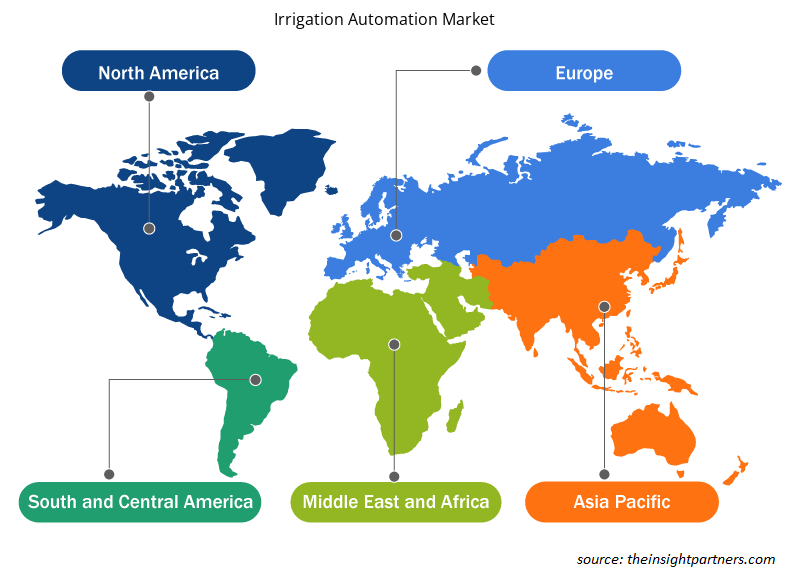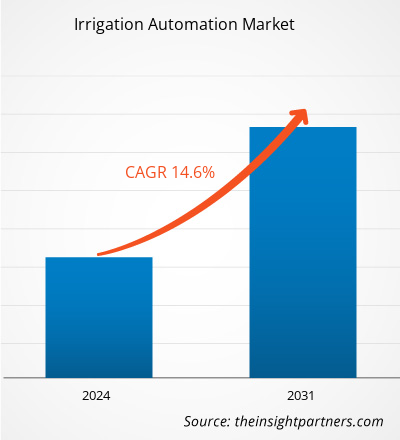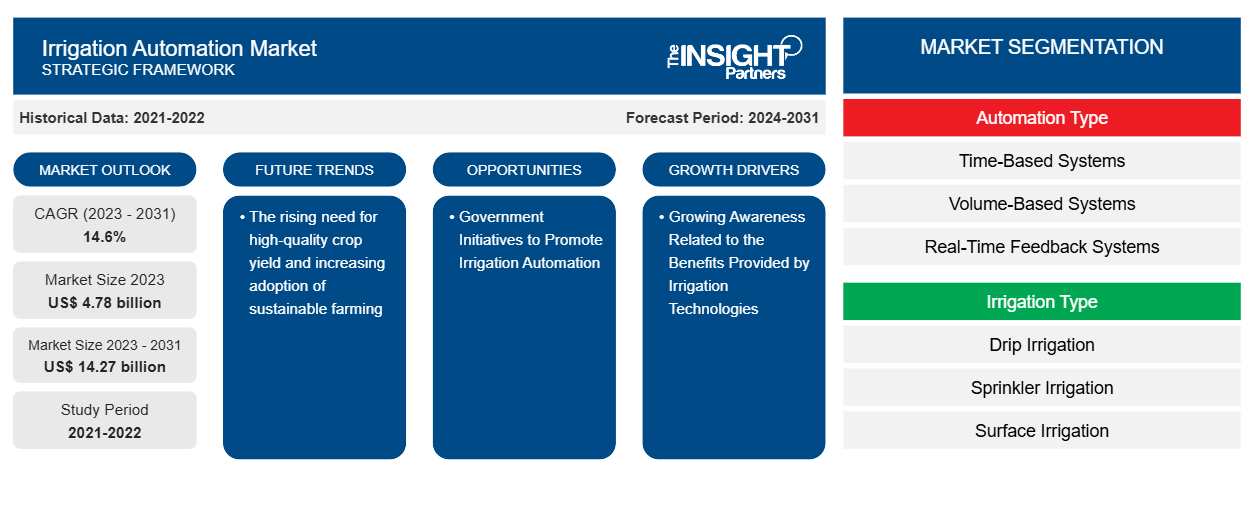灌溉自动化市场规模预计将从 2023 年的 47.8 亿美元增至 2031 年的 142.7 亿美元。预计 2023-2031 年市场复合年增长率将达到 14.6%。对优质作物产量的需求不断增长以及可持续农业的采用日益增加,可能仍是灌溉自动化市场的主要趋势。
灌溉自动化市场分析
随着人们对灌溉技术带来的好处的认识不断提高,以及精准农业仪器和技术的接受度不断提高,灌溉自动化市场正在快速增长。在对智能农业技术日益增长的需求的推动下,市场正在稳步扩张。此外,技术进步和政府推动灌溉自动化的举措为市场增长提供了丰厚的机会。
灌溉自动化市场概况
灌溉自动化使用仪器或设备来操作各种灌溉系统并改变水位。灌溉自动化包括多种硬件的组合,例如传感器、阀门、控制器、喷头等,以构建用于农业和非农业应用的自动化系统。灌溉自动化提供的显著优势(例如节省时间、成本效益、资源优化等)正在推动市场的发展。
定制此报告以满足您的需求
您可以免费定制任何报告,包括本报告的部分内容、国家级分析、Excel 数据包,以及为初创企业和大学提供优惠和折扣
-
获取此报告的关键市场趋势。这个免费样品将包括数据分析,从市场趋势到估计和预测。
灌溉自动化市场驱动因素和机遇
人们对灌溉技术带来的好处的认识不断提高,推动着市场的发展
农民越来越意识到与高昂的劳动力和电力成本相关的自动化灌溉技术。灌溉技术为用户提供了显著的好处,例如节水、过程自动化和节省成本等,这些都推动了市场的发展。这些好处提高了农民的认识,从而推动了灌溉技术的采用。这些技术帮助农民减少日常用电量,并减少灌溉所花费的时间和精力。此外,农民能够通过自动化减少农场出行次数,从而降低劳动力支出。安装自动灌溉系统可以通过确定准确的水量和灌溉时间来提高农业精度。这种精度减少了农民的作物损失并提高了总生产力。
政府推动灌溉自动化的举措——灌溉自动化市场的机会
欠发达国家的大多数农民采用传统灌溉系统(地面灌溉),这是一个耗时的过程。这鼓励各国政府采取有利举措促进灌溉自动化,有望为市场创造机会。许多发展中国家的政府(如印度、中国、巴西、美国、法国和其他非洲国家)都提供购买滴灌和喷灌系统的补助金,以提高其灌溉系统的效率。此外,鼓励使用喷灌和滴灌系统的严格政策有助于农民在农场采用技术发达的系统,例如购买和重新安装农用灌溉设备(喷灌和滴灌系统)。这些因素在预测期内为市场创造了巨大的增长机会。
灌溉自动化市场报告细分分析
有助于得出灌溉自动化市场分析的关键部分是自动化类型、灌溉类型、组件、系统和最终用户。
- 根据自动化类型,市场分为基于时间的系统、基于容量的系统、实时反馈系统和基于计算机的灌溉控制系统。基于时间的系统部分在 2023 年占据了更大的市场份额。
- 根据灌溉类型,市场分为滴灌、喷灌和地面灌溉。滴灌部分在 2023 年占据了较大的市场份额。
- 就组件而言,市场细分为控制器、传感器、阀门、洒水器等。控制器部分在 2023 年占据了更大的市场份额。
- 根据系统,灌溉自动化市场分为全自动和半自动。2023 年,自动部分占据了更大的市场份额。
- 就最终用途而言,市场分为农业和非农业。农业领域在 2023 年占据了更大的市场份额。
灌溉自动化市场份额按地区分析
灌溉自动化市场报告的地理范围主要分为五个地区:北美、亚太、欧洲、中东和非洲、南美/南美和中美。
就收入而言,亚太地区占据了灌溉自动化市场的最大份额,因为该地区拥有广阔的农业用地和政府的大力支持。由于气候条件的快速变化和减少废物浪费的需求日益增加,预计市场在不久的将来会扩大。此外,在预测期内,技术进步和先进灌溉系统的发展正在推动市场的发展。
灌溉自动化市场区域洞察
Insight Partners 的分析师已详尽解释了预测期内影响灌溉自动化市场的区域趋势和因素。本节还讨论了北美、欧洲、亚太地区、中东和非洲以及南美和中美洲的灌溉自动化市场细分和地理位置。

- 获取灌溉自动化市场的区域特定数据
灌溉自动化市场报告范围
| 报告属性 | 细节 |
|---|---|
| 2023 年的市场规模 | 47.8亿美元 |
| 2031 年市场规模 | 142.7亿美元 |
| 全球复合年增长率(2023 - 2031) | 14.6% |
| 史料 | 2021-2022 |
| 预测期 | 2024-2031 |
| 涵盖的领域 |
按自动化类型
|
| 覆盖地区和国家 |
北美
|
| 市场领导者和主要公司简介 |
|
市场参与者密度:了解其对商业动态的影响
灌溉自动化市场正在快速增长,这得益于终端用户需求的不断增长,而这些需求又源于消费者偏好的不断变化、技术进步以及对产品优势的认识不断提高等因素。随着需求的增加,企业正在扩大其产品范围,进行创新以满足消费者的需求,并利用新兴趋势,从而进一步推动市场增长。
市场参与者密度是指在特定市场或行业内运营的企业或公司的分布情况。它表明在给定市场空间中,相对于其规模或总市场价值,有多少竞争对手(市场参与者)存在。
在灌溉自动化市场运营的主要公司有:
- 加尔康有限公司
- 亨特工业公司
- 意大利艾瑞泰克公司
- Jain 灌溉系统有限公司
- 林赛公司
- 纳尔逊灌溉公司
免责声明:上面列出的公司没有按照任何特定顺序排列。

- 了解灌溉自动化市场的主要参与者概况
灌溉自动化市场新闻和最新发展
灌溉自动化市场通过收集一手和二手研究后的定性和定量数据进行评估,其中包括重要的公司出版物、协会数据和数据库。以下是灌溉自动化市场和战略发展情况的列表:
- 2024 年 3 月,Rubicon Water 分享了其在乌兹别克斯坦-塔吉克斯坦边境的最新项目。在瑞士合作办公室和蓝色和平倡议的支持下,这个创新项目专注于跨境配送和测量,以促进跨境水管理方面的合作。除了改善灌溉用水管理外,Rubicon 的技术在地下水管理、补给计划和环境流动计划中发挥着越来越重要的作用,有助于保护重要的水资源和生态系统。(来源:Rubicon Water,新闻稿,2024 年)
灌溉自动化市场报告覆盖范围和交付成果
“灌溉自动化市场规模和预测(2021-2031 年)”报告对以下领域进行了详细的市场分析:
- 范围内所有主要细分市场的全球、区域和国家层面的市场规模和预测
- 市场动态,如驱动因素、限制因素和关键机遇
- 未来主要趋势
- 详细的 PEST/波特五力分析和 SWOT 分析
- 全球和区域市场分析涵盖关键市场趋势、主要参与者、法规和最新市场发展
- 行业格局和竞争分析,涵盖市场集中度、热点图分析、知名参与者和最新发展
- 详细的公司简介
- 历史分析(2 年)、基准年、预测(7 年)及复合年增长率
- PEST和SWOT分析
- 市场规模、价值/数量 - 全球、区域、国家
- 行业和竞争格局
- Excel 数据集
近期报告
客户评价
购买理由
- 明智的决策
- 了解市场动态
- 竞争分析
- 客户洞察
- 市场预测
- 风险规避
- 战略规划
- 投资论证
- 识别新兴市场
- 优化营销策略
- 提升运营效率
- 顺应监管趋势























 获取免费样品 - 灌溉自动化市场
获取免费样品 - 灌溉自动化市场